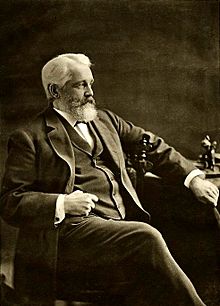Edward Atkinson (activist) facts for kids
Quick facts for kids
Edward Atkinson
|
|
|---|---|
 |
|
| Born | February 10, 1827 Brookline, Massachusetts, U.S.
|
| Died | December 11, 1905 (aged 78) Boston, Massachusetts, U.S.
|
| Nationality | American |
| Spouse(s) |
Mary Caroline Heath
(m. 1855; his d. 1905) |
| Institution | American Academy of Arts and Sciences American Anti-Imperialist League |
| Field | Economics, politics |
| School or tradition |
Liberalism |
| Alma mater | Dartmouth College University of South Carolina LL.D. |
| Influences |
|
| Contributions | Diffusion of anti-imperialism in the United States |
Edward Atkinson (born February 10, 1827 – died December 11, 1905) was an important American thinker. He was an economist, an inventor, and a strong activist. He helped start the American Anti-Imperialist League. This group worked against the United States taking over other countries.
Contents
Edward Atkinson's Early Life
Edward Atkinson was born in Brookline, Massachusetts. He went to private schools. He earned special degrees from Dartmouth College and the University of South Carolina. Before the American Civil War, Atkinson was a successful businessman. He managed some of the biggest cotton mills in New England. Later, he led two insurance companies in Boston.
In 1855, Atkinson married Mary Caroline Heath. They had nine children together. Seven of their children lived to be adults. One of their sons, Robert Whitman Atkinson, became a musician. He was known for composing a popular waltz in the 1890s.
In 1886, Edward Atkinson invented a special kitchen stove. It was called the "Aladdin cooker." This stove cooked food slowly using very little power. It was similar to the slow cookers we use today.
Fighting for What's Right
Atkinson strongly opposed slavery. He supported the Free Soil Party, which worked to stop slavery from spreading. He also helped the Boston Vigilance Committee. This group helped enslaved people who had escaped find freedom. He even raised money to buy weapons for John Brown, an activist who fought against slavery.
In 1866, Atkinson was chosen as a delegate for a big meeting in Philadelphia. He became a Fellow of the American Academy of Arts and Sciences in 1879.
He was inspired by thinkers like Adam Smith, Richard Cobden, and John Bright. He became a leading voice for free trade, which means countries can trade goods without high taxes. He also spoke out against ideas that would make money less valuable.

Atkinson supported Grover Cleveland for president. He was very upset by the United States' actions after the Spanish–American War. Presidents William McKinley and Theodore Roosevelt wanted to take control of other lands. Atkinson became a full-time activist against these ideas. He helped lead the American Anti-Imperialist League. He believed the U.S. should not get involved in other countries like Cuba and the Philippines.
As a leader of the Anti-Imperialist League, Atkinson wanted to send his pamphlets to soldiers in the Philippines. He asked the U.S. Department of War for a list of soldiers. When he didn't get a reply, he told the news that he was sending his writings to important generals and admirals.
On February 17, 1899, Edward Atkinson sent three pamphlets. He wanted to test if citizens had the right to send mail freely.
- "The Cost of a National Crime" explained how expensive the war in the Philippines was for American taxpayers. It also talked about the military actions against the Filipinos.
- "The Hell of War and Its Penalties"
- "Criminal Aggression: By Whom Committed?"
The U.S. Postmaster General, Charles Emory Smith, ordered these pamphlets to be stopped in San Francisco. He called them "seditious," meaning they encouraged rebellion. The U.S. Attorney General thought about charging Atkinson with serious crimes. However, they decided not to. They worried that charging the 72-year-old Atkinson would only make him seem like a hero.
Newspapers that supported U.S. expansion called Atkinson a "latter-day copperhead." This was a term used for people who opposed the government during the Civil War. Atkinson seemed to enjoy this attention. He thanked the government for making his essays famous and increasing their demand across the country.
Later Life and Legacy
Edward Atkinson passed away on December 11, 1905. He was 78 years old.
Atkinson's writings and papers are kept at the Massachusetts Historical Society. They include many boxes and books of his materials.
Edward Atkinson's Writings
For almost 40 years, Atkinson wrote and shared many brochures. He wrote about banking, business, cotton manufacturing, and how to prevent fires. He also wrote about money, taxes, and education. In 1899, he published a series of pamphlets called "The Anti-Imperialist." Some of his other important works include:
- Cheap Cotton by Free Labor (Boston, 1861)
- The Distribution of Products (New York, 1885)
- Margin of Profits (1887)
- Industrial Progress of the Nation (1889)
- Taxation and Work: A Series of Treatises on the Tariff and the Currency (New York 1892)

